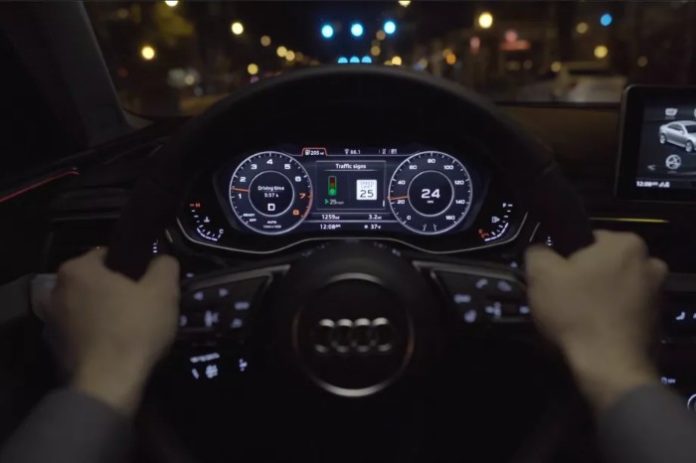Audi may have finally solved the red light problem. Traffic is always horrible, but if you’re stuck in red light after red light, the experience is downright torture.
A new Audi feature calculates the speed you need to maintain to catch the next green light. The system was tested previously on the A4 and Q7 models. Now, it’s available on all 2019 models except the A3, TT, and R8.
A new graphic element is located on the digital dashboard, between the odometer and speedometer. If you maintain the recommended speed, you should be able to drive continuously to your destination. It’s called GLOSA – short for Green Light Optimized Speed Advisory. It works by solving one of the most basic physics equations – distance equals speed multiplied by time.
Audi uses the onboard navigation to calculate the distance to the next traffic light. The car gets data for the traffic light programming from Audi’s technology partner – Traffic Technology Services. So it knows when the traffic lights cycle green and red and how long each color stays. Now, the car can easily solve for speed.
Of course, it always obeys the speed limits and will never ask you to drive faster than the law permits. The interface also displays the speed limit for you, giving you every chance of obeying traffic laws and staying safe.
For now, Traffic Technology Services has limited availability. They collect data from 4,700 intersections in 13 major cities, among which:
- Dallas
- Denver
- Houston
- Los Angeles
- Orlando
- Phoenix
- San Francisco
- Washington, DC
We’re sure that Audi will recruit more data partners in time and expand its range of service across the globe. But what are the benefits of GLOSA ?
For Audi, it’s mostly a comfort feature. GLOSA won’t transport you faster. However, by driving continuously, without stopping at red lights, your commute will be less stressful. Also, the overall emissions during your route will decrease. You’ll spend less time idling in red lights and the engine will mostly run in a constant and efficient RPM band.
Last but not least, being able to communicate with traffic lights and other infrastructure is a mandatory part of future autonomous cars.
